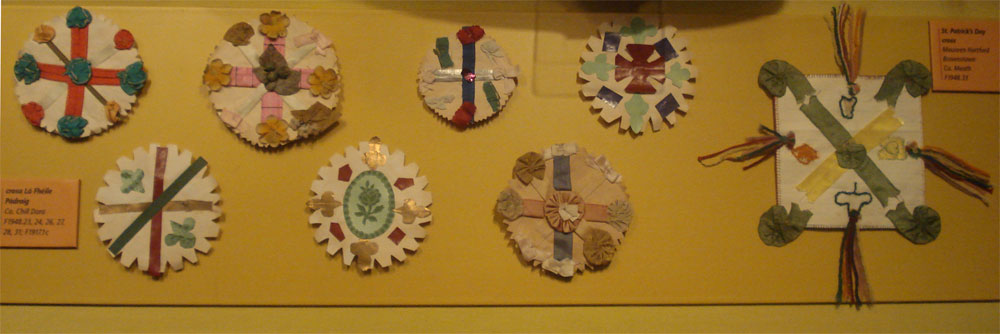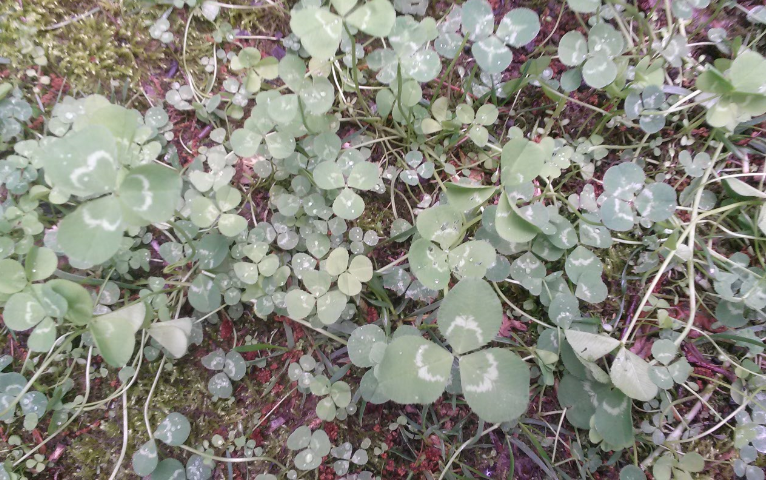|
Shamrock
A shamrock is a type of clover, used as a symbol of Ireland. The name ''shamrock'' comes from Irish (), which is the diminutive of the Irish word and simply means "young clover". At most times'', Shamrock'' refers to either the species (lesser/yellow clover, Irish: ) or ''Trifolium repens'' (white clover, Irish: ). However, other glossary of leaf morphology#trifoliate, three-leaved plants—such as ''Medicago lupulina'', ''Trifolium pratense'', and ''Oxalis acetosella''—are sometimes called shamrocks. The shamrock was traditionally used for its Herbalism, medicinal properties, and was a popular motif (visual arts), motif in Victorian era, Victorian times. Botanical species There is still not a consensus over the precise Botany, botanical species of clover that is the "true" shamrock. John Gerard in his herbal of 1597 defined the shamrock as ''Trifolium pratense'' or ''Trifolium pratense flore albo'', meaning red or red clover with white flowers. He described the p ... [...More Info...] [...Related Items...] OR: [Wikipedia] [Google] [Baidu] |
Saint Patrick's Day
Saint Patrick's Day, or the Feast of Saint Patrick (), is a religious and cultural holiday held on 17 March, the traditional death date of Saint Patrick (), the foremost patron saint of Ireland. Saint Patrick's Day was made an official Christian feast day in the early 17th century and is observed by the Catholic Church, the Anglican Communion (especially the Church of Ireland), the Eastern Orthodox Church, and the Lutheranism, Lutheran Church. The day commemorates Saint Patrick and the arrival of Christianity in Ireland, and, by extension, celebrates the Culture of Ireland, heritage and culture of the Irish in general. Celebrations generally involve public parades and festivals, céilithe, and the wearing of green attire or shamrocks. Christians who belong to liturgical denominations also attend church services. Historically, the Lenten restrictions Christian fasting, on fasting and Christianity and alcohol, drinking alcohol were lifted for the day, which has encouraged the ho ... [...More Info...] [...Related Items...] OR: [Wikipedia] [Google] [Baidu] |
Clover And Woodsorrel
Clovers, also called trefoils, are plants of the genus ''Trifolium'' (), consisting of about 300 species of flowering plants in the legume family Fabaceae originating in Europe. The genus has a cosmopolitan distribution with the highest diversity in the temperate Northern Hemisphere, but many species also occur in South America and Africa, including at high altitudes on mountains in the tropics. They are small annual, biennial, or short-lived perennial herbaceous plants, typically growing up to tall. The leaves are trifoliate (rarely, they have more or fewer than three leaflets; the more (or fewer) leaflets the leaf has, the rarer it is; see four-leaf clover), with stipules adnate to the leaf-stalk, and heads or dense spikes of small red, purple, white, or yellow flowers; the small, few-seeded pods are enclosed in the calyx. Other closely related genera often called clovers include '' Melilotus'' (sweet clover) and '' Medicago'' (alfalfa or Calvary clover). As legumes, clo ... [...More Info...] [...Related Items...] OR: [Wikipedia] [Google] [Baidu] |
Nathaniel Colgan
Nathaniel Colgan (1851 Dublin – 1919 Dublin) was a self-taught Irish naturalist primarily known for his botanical work. Life Very little is known about Colgan's early life, but it is believed his parents may have been Nathaniel Watson Colgan and Letitia Phair. If correct his father, a pawnbroker, died on 23 January 1863 at Bishop-street, Dublin City and his mother died 26 April 1865, at Rehoboth House, South Circular Road, Dolphin's Barn just prior to Nathaniel's fourteenth birthday. After leaving the Incorporated School, Angier Street, Dublin City, Colgan began work as a clerk and from the age of twenty worked in the Dublin Metropolitan Police Court remaining there until his retirement in 1916. He began visiting Europe every summer from 1875, and these trips inspired many of the contributions to a magazine of literary manuscripts, ''Varieties''. He was a regular contributor to the magazine from 1873 and edited it for a number of years. Colgan also contributed to '' Irish Mo ... [...More Info...] [...Related Items...] OR: [Wikipedia] [Google] [Baidu] |
Trifolium Repens Leaf April 2, 2010
Clovers, also called trefoils, are plants of the genus ''Trifolium'' (), consisting of about 300 species of flowering plants in the legume family Fabaceae originating in Europe. The genus has a cosmopolitan distribution with the highest diversity in the temperate Northern Hemisphere, but many species also occur in South America and Africa, including at high altitudes on mountains in the tropics. They are small annual, biennial, or short-lived perennial herbaceous plants, typically growing up to tall. The leaves are trifoliate (rarely, they have more or fewer than three leaflets; the more (or fewer) leaflets the leaf has, the rarer it is; see four-leaf clover), with stipules adnate to the leaf-stalk, and heads or dense spikes of small red, purple, white, or yellow flowers; the small, few-seeded pods are enclosed in the calyx. Other closely related genera often called clovers include '' Melilotus'' (sweet clover) and '' Medicago'' (alfalfa or Calvary clover). As legumes, clo ... [...More Info...] [...Related Items...] OR: [Wikipedia] [Google] [Baidu] |
Clover
Clovers, also called trefoils, are plants of the genus ''Trifolium'' (), consisting of about 300 species of flowering plants in the legume family Fabaceae originating in Europe. The genus has a cosmopolitan distribution with the highest diversity in the temperate Northern Hemisphere, but many species also occur in South America and Africa, including at high altitudes on mountains in the tropics. They are small annual, biennial, or short-lived perennial herbaceous plants, typically growing up to tall. The leaves are trifoliate (rarely, they have more or fewer than three leaflets; the more (or fewer) leaflets the leaf has, the rarer it is; see four-leaf clover), with stipules adnate to the leaf-stalk, and heads or dense spikes of small red, purple, white, or yellow flowers; the small, few-seeded pods are enclosed in the calyx. Other closely related genera often called clovers include '' Melilotus'' (sweet clover) and '' Medicago'' (alfalfa or Calvary clover). As legume ... [...More Info...] [...Related Items...] OR: [Wikipedia] [Google] [Baidu] |
Trifolium Dubium Kz1
Clovers, also called trefoils, are plants of the genus ''Trifolium'' (), consisting of about 300 species of flowering plants in the legume family Fabaceae originating in Europe. The genus has a cosmopolitan distribution with the highest diversity in the temperate Northern Hemisphere, but many species also occur in South America and Africa, including at high altitudes on mountains in the tropics. They are small annual, biennial, or short-lived perennial herbaceous plants, typically growing up to tall. The leaves are trifoliate (rarely, they have more or fewer than three leaflets; the more (or fewer) leaflets the leaf has, the rarer it is; see four-leaf clover), with stipules adnate to the leaf-stalk, and heads or dense spikes of small red, purple, white, or yellow flowers; the small, few-seeded pods are enclosed in the calyx. Other closely related genera often called clovers include '' Melilotus'' (sweet clover) and '' Medicago'' (alfalfa or Calvary clover). As legumes, clo ... [...More Info...] [...Related Items...] OR: [Wikipedia] [Google] [Baidu] |
Trifolium Dubium
''Trifolium dubium'', the lesser trefoil, suckling clover, little hop clover or lesser hop trefoil, is a flowering plant in the pea and clover family Fabaceae. This species is generally accepted as the primary plant to represent the traditional Irish shamrock. It is native to Europe, but can be found in many parts of the world as an introduced species An introduced species, alien species, exotic species, adventive species, immigrant species, foreign species, non-indigenous species, or non-native species is a species living outside its native distributional range, but which has arrived ther .... It is probably an allotetraploid with 2n=32 that arose from the crossing of '' Trifolium campestre'' and '' T. micranthum''.Ansari, H. A., et al. (2008). Molecular and cytogenetic evidence for an allotetraploid origin of ''Trifolium dubium'' (Leguminosae). ''Chromosoma'' 117(2):159-67. Gallery File:TrifoliumDubium-bloem-hr.jpg File:Trif dubium210ss.JPG File:Trif dubium204ss.JPG ... [...More Info...] [...Related Items...] OR: [Wikipedia] [Google] [Baidu] |
Wood Sorrel
''Oxalis'' ( (British English) or (American English)) is a large genus of flowering plants in the wood-sorrel family, Oxalidaceae, comprising over 550 species. The genus occurs throughout most of the world, except for the polar areas; species diversity is particularly rich in tropical Brazil, Mexico, and South Africa. Many of the species are known as wood-sorrels (also as wood sorrels or woodsorrels) as they have an acidic taste reminiscent of the sorrel proper (''Rumex acetosa''), which is not closely related. Some species are called yellow sorrels or pink sorrels after the colour of their flowers instead. Other species are colloquially known as false shamrocks, and some called sourgrasses. For the genus as a whole, the term oxalises is also used. Description The plants are annual or perennial. The leaves are divided into three to ten or more obovate and top-notched leaflets, arranged palmately with all the leaflets of roughly equal size. The majority of species have three ... [...More Info...] [...Related Items...] OR: [Wikipedia] [Google] [Baidu] |
Herbalism
Herbal medicine (also called herbalism, phytomedicine or phytotherapy) is the study of pharmacognosy and the use of medicinal plants, which are a basis of traditional medicine. Scientific evidence for the effectiveness of many herbal treatments remains limited, prompting ongoing regulatory evaluation and research into their safety and efficacy. Standards for purity or dosage are generally not provided. The scope of herbal medicine sometimes includes fungi, fungal and bee products, as well as Dietary mineral, minerals, Exoskeleton, shells and certain animal parts. Paraherbalism is the Pseudoscience, pseudoscientific use of plant or animal extracts as medicine, relying on unproven beliefs about the safety and effectiveness of minimally processed natural substances. Herbal medicine has been used since at least the Paleolithic era, with written records from ancient Sumer, Egypt, Greece, China, and India documenting its development and application over millennia. Modern herbal medici ... [...More Info...] [...Related Items...] OR: [Wikipedia] [Google] [Baidu] |



